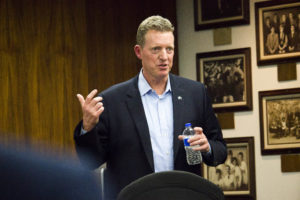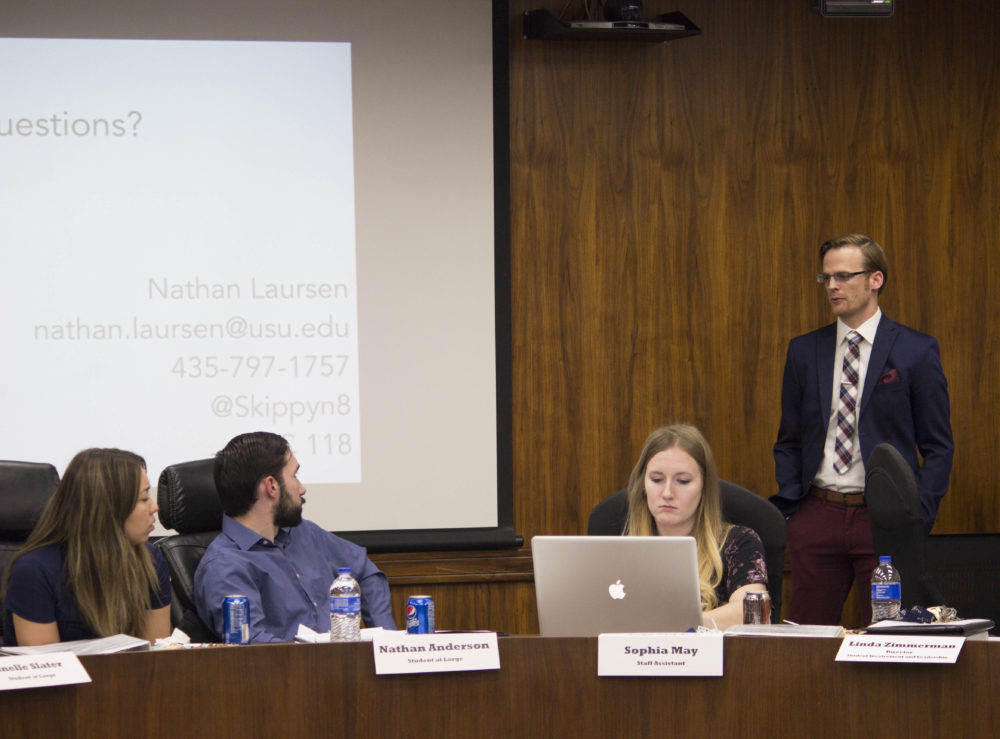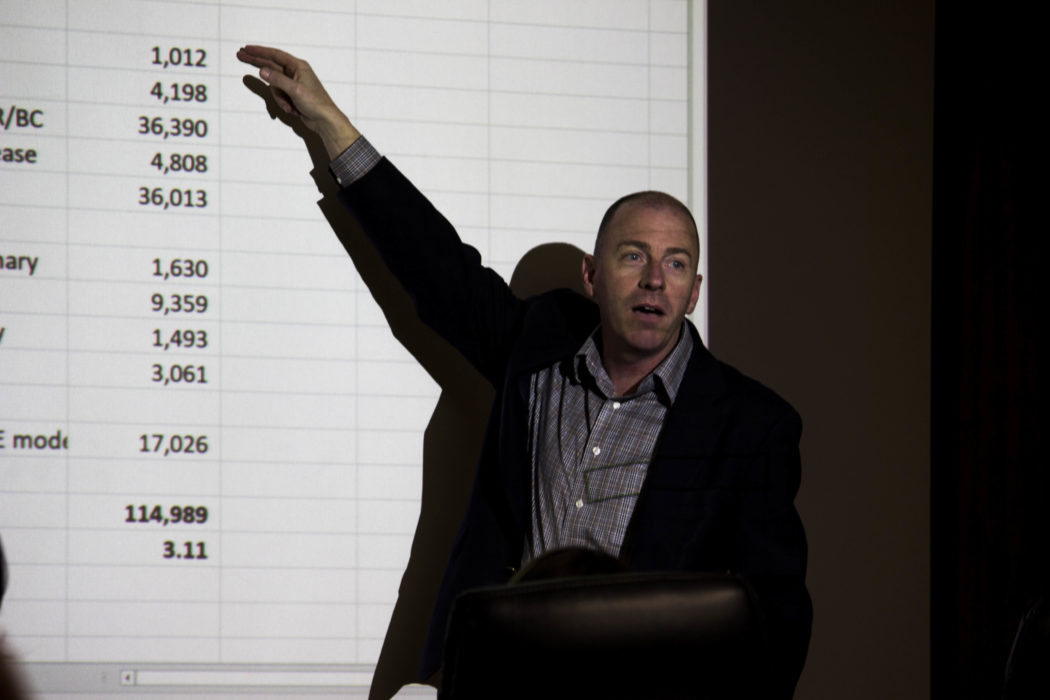Fee board hears proposals for 2018 student fee increases
The start of Spring semester at Utah State University brought with it an annual meeting to decide whether student fees will increase for the coming years.
The USU Student Fee Board met Wednesday to hear two requests from different student-funded organizations on campus for a student-approved increase in their budgets.
On the table was an $8 student fee increase for the university’s athletics department and a $3.11 increase for the information technology department.
This is the third year in a row John Hartwell, the vice president and director of athletics at USU, asked the board for an increase to the $135.14* athletics student fee. Two previous increase requests — one for $10 in 2016 and another for $7 in 2017 — were denied.
The proposed $8 increase would net the department an additional $297,000 per year, money Hartwell said would be used to fund two new programs: Spectra, which would allow e-ticketing for athletics and other events; and Fanmaker, an application intended to help incentivize student attendance at games.
Spectra, Fanmaker and related hardware account for $35,000 of the requested $297,000. A larger portion of the money would be used to cover a $1 ticket claim fee charged by the Spectra system.

John Hartwell presents the USU Fee Board with his proposal for an $8 increase to the athletics student fee in a meeting held Wednesday, Jan. 10, 2017.
Hartwell estimated covering the $1 fee for every student ticket would cost $105,000 ($37,500 for football tickets, $60,000 for basketball and $7,500 for other student events, like The Howl).
The remainder of the $297,000 — amounting to about $85,000 — would be used for “athletics operations uses,” which Hartwell said include money to “help us stay level” with the rising costs of hotel rooms and transportation to out-of-state games.
“There are so many groups who utilize student fees and we are very respectful of that and also respectful of you all as individual consumers,” Hartwell said, “so we don’t take lightly asking for a fee increase, but at the same time, we really feel like athletics are a vibrant part of the overall college experience and ask that you give this serious consideration.”
Most board members said they were not in favor of the proposal or described themselves as “neutral, leaning ‘no.’”
Nathan Anderson, a student-at-large who also served on the board and heard Hartwell’s proposal last year, said he thought this year’s proposal was “basically the same as last year, and we opted not to give it to them.”
Other board members expressed concern that the athletics department had failed to demonstrate a need for the technology they sought through the proposed increase.
“I’ve never heard anyone say, ‘I wish I could have a ticket on my phone,’” said organizations and campus diversity vice president Chelsea Yoshikawa.
Some members, Yoshikawa included, hinted they might approve an increase if it were put toward something else.
“Do I think athletics could use more money? Yes. But for a ticketing system, not so much,” she said. “I would personally rather see money go to the teams, to develop them.”
College of Engineering Senator Erik Olson said he loved that $85,000 would be used for student promotions.
“I’m OK with money going back to students,” he said.
Others pointed out what they thought were different issues, like the $20,000 of ongoing fees budgeted for a one-time hardware purchase associated with the Fanmaker application.
Other board members said they found “athletics operations uses” too vague a description to merit an additional $72,000 in budget.
A few, however, argued that perhaps the board should try to recognize the value of fees to other people and to the university as a whole, and pointed out that technology only gets more expensive as time goes on.
“If not now, when?” asked College of Agriculture and Applied Sciences Senator Heather Lieber.
USU Student Association President Michael Scott Peters compared Spectra and Fanmaker to innovations like cars and the iPhone.
“There are a lot of things that we don’t know we need until we have them and appreciate them,” he said.
Board members expressed fewer concerns about the IT Computer Labs’ proposed $3.11 fee increase.
If approved, money from the increase would be put toward the inflationary costs of software licensing (about $25,561), as well as purchasing cloud-based malware protection (36,013) and a move to “push Banner out to use the cloud instead of hosting it on local hardware ($36,390),” said Eric Hawley, the assistant vice president and CIO of Information Technology at USU.
Though the fee board appeared largely in favor of the proposed increase, some members expressed concern that the money would be coming from an increase in student fees, rather than Tier II tuition.
Hawley said if the board were to deny the request, he thought he could get the money from another source within the university, but that the fee increase had been proposed as part of “a change that we have been asked to make.”
For the last 8 years, money for software licensing and other IT needs came from Tier II tuition and increases to the faculty equivalent of student fees, Hawley said.
“This year, President Cockett has asked us to come to the students and to ask you to take part in participating in the software increases that benefit all of campus,” Hawley said.
One point of concern was the $17,026 in student funds Hawley said would be used to support an anticipated 2 percent salary increase for all employees of Utah’s state-funded higher education institutions — including IT employees. This increase has yet to be approved by the Utah Legislature.
USU Student Media asked the board not for a fee increase, but for a reclassification of its fee to combine both its departments — the Utah Statesman and Aggie Radio — into one fee: the student media fee.

Nate Laursen, USU’s student media program coordinator, asked for a reclassification of the Utah Statesman student fee at a meeting of the USU Fee Board held Wednesday, Jan. 10, 2017.
Nate Laursen, the student media program coordinator, said he thought the reclassification would “increase revenue and the quality of what we’re doing,” by allowing students in all of student media’s programs to benefit from student fees, not just The Statesman.
One concern about reclassifying the fee, Laursen acknowledged, was that it might lead student media to request a fee increase in the coming years.
“I can’t predict the future,” Laursen said. “I’m not saying we won’t, but I’m saying you can look at our past and see that we only come for student fees as a last resort.”
An unofficial vote conducted later in the meeting revealed a majority of the fee board was in favor of the proposed reclassification.
The board will meet again in two weeks.
@alyssarbrts
*This amount and others used reflect the cost for a student taking 12-18 credits. A breakdown of student fees can be found here.

